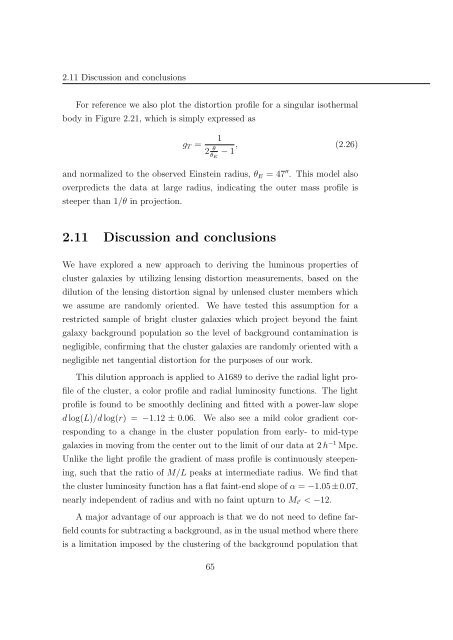Mass and Light distributions in Clusters of Galaxies - Henry A ...
Mass and Light distributions in Clusters of Galaxies - Henry A ...
Mass and Light distributions in Clusters of Galaxies - Henry A ...
You also want an ePaper? Increase the reach of your titles
YUMPU automatically turns print PDFs into web optimized ePapers that Google loves.
2.11 Discussion <strong>and</strong> conclusions<br />
For reference we also plot the distortion pr<strong>of</strong>ile for a s<strong>in</strong>gular isothermal<br />
body <strong>in</strong> Figure 2.21, which is simply expressed as<br />
g T =<br />
1<br />
2 θ<br />
θ E<br />
− 1 , (2.26)<br />
<strong>and</strong> normalized to the observed E<strong>in</strong>ste<strong>in</strong> radius, θ E = 47 ′′ . This model also<br />
overpredicts the data at large radius, <strong>in</strong>dicat<strong>in</strong>g the outer mass pr<strong>of</strong>ile is<br />
steeper than 1/θ <strong>in</strong> projection.<br />
2.11 Discussion <strong>and</strong> conclusions<br />
We have explored a new approach to deriv<strong>in</strong>g the lum<strong>in</strong>ous properties <strong>of</strong><br />
cluster galaxies by utiliz<strong>in</strong>g lens<strong>in</strong>g distortion measurements, based on the<br />
dilution <strong>of</strong> the lens<strong>in</strong>g distortion signal by unlensed cluster members which<br />
we assume are r<strong>and</strong>omly oriented. We have tested this assumption for a<br />
restricted sample <strong>of</strong> bright cluster galaxies which project beyond the fa<strong>in</strong>t<br />
galaxy background population so the level <strong>of</strong> background contam<strong>in</strong>ation is<br />
negligible, confirm<strong>in</strong>g that the cluster galaxies are r<strong>and</strong>omly oriented with a<br />
negligible net tangential distortion for the purposes <strong>of</strong> our work.<br />
This dilution approach is applied to A1689 to derive the radial light pr<strong>of</strong>ile<br />
<strong>of</strong> the cluster, a color pr<strong>of</strong>ile <strong>and</strong> radial lum<strong>in</strong>osity functions. The light<br />
pr<strong>of</strong>ile is found to be smoothly decl<strong>in</strong><strong>in</strong>g <strong>and</strong> fitted with a power-law slope<br />
d log(L)/d log(r) = −1.12 ± 0.06. We also see a mild color gradient correspond<strong>in</strong>g<br />
to a change <strong>in</strong> the cluster population from early- to mid-type<br />
galaxies <strong>in</strong> mov<strong>in</strong>g from the center out to the limit <strong>of</strong> our data at 2 h −1 Mpc.<br />
Unlike the light pr<strong>of</strong>ile the gradient <strong>of</strong> mass pr<strong>of</strong>ile is cont<strong>in</strong>uously steepen<strong>in</strong>g,<br />
such that the ratio <strong>of</strong> M/L peaks at <strong>in</strong>termediate radius. We f<strong>in</strong>d that<br />
the cluster lum<strong>in</strong>osity function has a flat fa<strong>in</strong>t-end slope <strong>of</strong> α = −1.05±0.07,<br />
nearly <strong>in</strong>dependent <strong>of</strong> radius <strong>and</strong> with no fa<strong>in</strong>t upturn to M i ′ < −12.<br />
A major advantage <strong>of</strong> our approach is that we do not need to def<strong>in</strong>e farfield<br />
counts for subtract<strong>in</strong>g a background, as <strong>in</strong> the usual method where there<br />
is a limitation imposed by the cluster<strong>in</strong>g <strong>of</strong> the background population that<br />
65
















